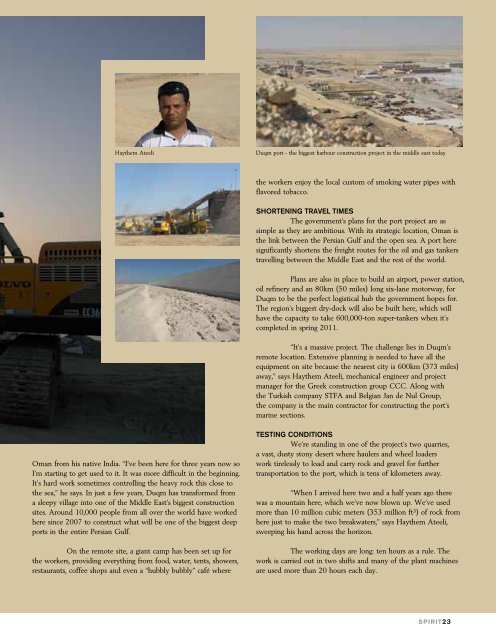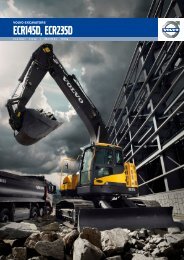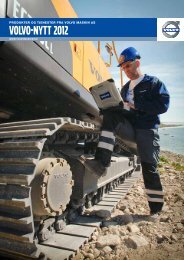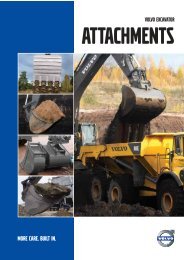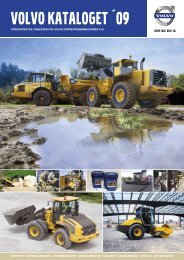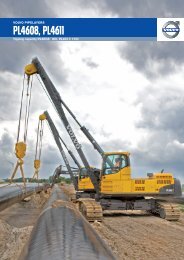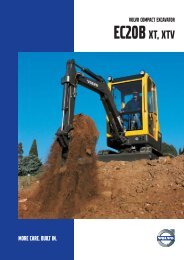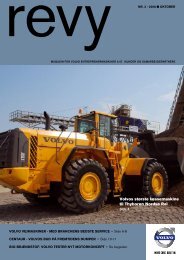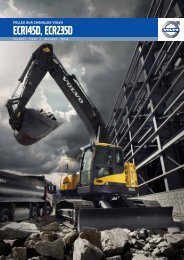Spirit 38 - Volvo Construction Equipment
Spirit 38 - Volvo Construction Equipment
Spirit 38 - Volvo Construction Equipment
Create successful ePaper yourself
Turn your PDF publications into a flip-book with our unique Google optimized e-Paper software.
Haythem Ateeli<br />
Duqm port - the biggest harbour construction project in the middle east today<br />
the workers enjoy the local custom of smoking water pipes with<br />
flavored tobacco.<br />
Shortening travel times<br />
The government’s plans for the port project are as<br />
simple as they are ambitious. With its strategic location, Oman is<br />
the link between the Persian Gulf and the open sea. A port here<br />
significantly shortens the freight routes for the oil and gas tankers<br />
travelling between the Middle East and the rest of the world.<br />
Plans are also in place to build an airport, power station,<br />
oil refinery and an 80km (50 miles) long six-lane motorway, for<br />
Duqm to be the perfect logistical hub the government hopes for.<br />
The region’s biggest dry-dock will also be built here, which will<br />
have the capacity to take 600,000-ton super-tankers when it’s<br />
completed in spring 2011.<br />
“It’s a massive project. The challenge lies in Duqm’s<br />
remote location. Extensive planning is needed to have all the<br />
equipment on site because the nearest city is 600km (373 miles)<br />
away,” says Haythem Ateeli, mechanical engineer and project<br />
manager for the Greek construction group CCC. Along with<br />
the Turkish company STFA and Belgian Jan de Nul Group,<br />
the company is the main contractor for constructing the port’s<br />
marine sections.<br />
Oman from his native India. “I’ve been here for three years now so<br />
I’m starting to get used to it. It was more difficult in the beginning.<br />
It’s hard work sometimes controlling the heavy rock this close to<br />
the sea,” he says. In just a few years, Duqm has transformed from<br />
a sleepy village into one of the Middle East’s biggest construction<br />
sites. Around 10,000 people from all over the world have worked<br />
here since 2007 to construct what will be one of the biggest deep<br />
ports in the entire Persian Gulf.<br />
On the remote site, a giant camp has been set up for<br />
the workers, providing everything from food, water, tents, showers,<br />
restaurants, coffee shops and even a “hubbly bubbly” café where<br />
Testing conditions<br />
We’re standing in one of the project’s two quarries,<br />
a vast, dusty stony desert where haulers and wheel loaders<br />
work tirelessly to load and carry rock and gravel for further<br />
transportation to the port, which is tens of kilometers away.<br />
“When I arrived here two and a half years ago there<br />
was a mountain here, which we’ve now blown up. We’ve used<br />
more than 10 million cubic meters (353 million ft³) of rock from<br />
here just to make the two breakwaters,” says Haythem Ateeli,<br />
sweeping his hand across the horizon.<br />
The working days are long: ten hours as a rule. The<br />
work is carried out in two shifts and many of the plant machines<br />
are used more than 20 hours each day.<br />
SPIRIT23


